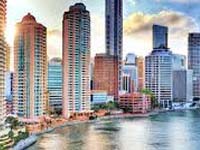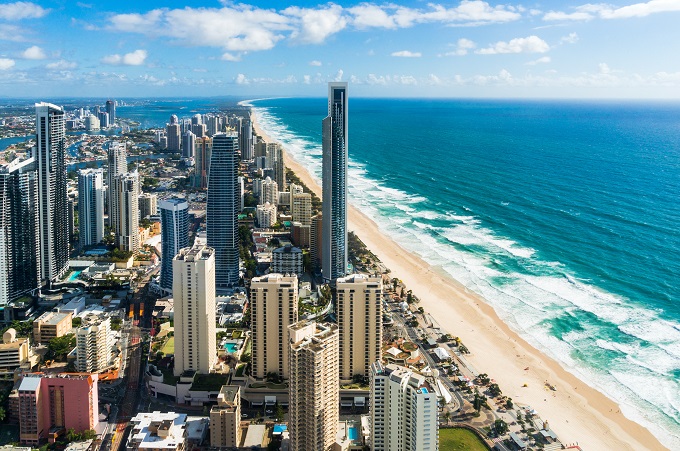
The shift to leisure based management rights and motels
This article is to discuss where the market has been and where we anticipate there will be growth in demand and output both sector and location specific.
Some two years ago I wrote an article to explain the phenomenon of increased demand and interest for corporate based accommodation in regional Queensland centres. That discussion coincided with the peak in the mining boom, and now with the mining boom being over we are now seeing a swing back towards leisure based properties and locations.
For this discussion we have used statistics dating back to 2006 in the pre-Global Financial Crisis (GFC) era. The GFC started in 2007 but it was 2008 when it really started to “bite”. Whilst it affected most businesses and industries, it was the tourism industry that was significantly affected for two reasons: 1. being that tourism and holidays are a discretional spend, and discretional expenditure is restricted in times of business contraction, and; 2. the rising of the Australian dollar resulted in overseas travel being more affordable whilst similarly travel to Australia became more expensive. The resultant effect was lower domestic visitations and lower international visitations.
There were four main outcomes interplaying, namely:
- lower international visitations
- higher volumes of Australians holidaying abroad
- less domestic travel and expenditure
- lower volume of corporate expenditure in the conference/meeting and incentive markets
Accommodation Metrics
When analysing the accommodation industry, we like to review multiple factors. The statistics we use an an industry are:
- RevPar and Occupancy
- International Visitation Numbers, with particular reference to tourism destinations
- Exchange rates and other economic drivers, such as commodity prices and the price of coal
- Anecdotal evidence from operators and industry participants
The hotel and finance market use the metric of revenue per available Room (RevPar). We have been monitoring the accommodation statistics since 2000 and we have consistently plotted the RevPar, Occupancy and Room Rates for this research. A commonly occurring problem with leisure based destinations is the seasonality of the business with the beachside locations having the prime occupancies in the summer and school holiday periods. It is for these reasons we have focussed on annualised figures and made relativity to the previous 12 months figures.
Demand in Corporate Accommodation
Leading up to and even midway through 2012, there was strong demand in locations like Mackay, Gladstone and Toowoomba. It was also no co-incidence that these towns were influenced by the growth in the mining industry.
The cities of Mackay and Gladstone were in high demand as the mining boom was accompanied with more expansion in exploration and output in the coal industry. Gladstone was somewhat unique in that the expansion it experienced was mainly attributable to the development of the coal seam gas industry and the need for LNG processing plants which were to be located on Curtis Island in Gladstone Harbour. There was still construction of the Wiggan Island Coal Terminal in addition to the already high level of construction and associated works with Gladstone’s industrial base.
Mackay witnessed RevPar growth of 20% from 2011 to 2012, and Gladstone saw revPar growth of 96% in the same period. It was the forces of Supply and Demand playing out. Importantly in Gladstone some motels were acquired by companies to house their workforce, thus reducing supply. There were also “block bookings” which further exacerbated the problem. The growth in RevPar is evident in Chart 1. The lack of supply also helped fuel the local housing market as companies placed their itinerant staff into housing.
Gladstone and Mackay became a perennial problem for the corporate travel agencies and the consortia. The levels of denials were high. It was also a time of “super profits” made by the hotels. This was not just isolated to Mackay and Gladstone and accommodation shortages occurred in Moranbah, Dysart, Emerald, Blackwater and Bowen
Mackay, Gladstone and Rockhampton have historically been attractive towns to accommodation operators and is was during the 2011/2012 where they made higher than average profits. It was a period where operators did not want to sell and prospective purchasers wanted to acquire.
The attraction of these corporate towns was:
- historically popular towns before the mining boom
- higher profit margins
- block bookings, with multiple rooms and longer length of stay from each booking communication
- once in-house, a low demand for facilities
- pattern of booking allows for the reduction of hours of operation
- lack of choice and availability resulted in reduction of renovations and capital injection.

The Market in both Mackay and Gladstone and to a lesser extent in Rockhampton have responded in typical fashion with new accommodation stocked being planned and developed. In Mackay there is a new Oak development under construction and a further 60 apartment development opposite in River Street. In Gladstone there is a new __ room Oaks development under construction, the recent Mecure development and other proposed around the periphery. In Rockhampton, there is a new Quest and a commercial office building conversion of into a 60 room Quality Inn in the centre of town.
Back in 2012 the Australian dollar was high with a peak back in July 2011. Thermal coal prices peaked in January 2011.The economic discussion coming out of Europe in the post GFC was still about the size and quantum of the economic bailouts. It is now widely accepted that the US economy has now bottomed and is improving as the Federal Reserve has slowed down their quantitative easing program.
It can be seen in the above graph above that the peak in RevPar lags some 6 months behind the peak in the coal price.
The downside to the fall in the mining boom have been felt in towns like Bowen where one motel has experienced a fall in occupancy from 90+% to 30%, and a motel in the southern Bowen Basin losing some 70% of their occupancy when coal mines were announced to be closed.
The Shift to Tourism
In the mining towns it is widely accepted that the financial year of 2011/2012 was one of the best and that the net profit in that financial year was higher than the previous and following years. This is evident in the graph above. We have inserted trend lines over the ABS data, and it can be seen that the turning point for Mackay was mid 2012. The slowdown in the Mackay economy came when BMA closed the Norwich Park mine in late February 2012. Further closures occurred subsequently in the Bowen Basin. By contrast the RevPar at Airlie Beach started to rise at this time, and helped on by a falling Australian dollar. This can be seen in Chart 3 below.

As the market neared its peak, the occupancy rate increased to near 100% midweek yet the visitor numbers were down. This was often due to “block bookings”. Block bookings were made by companies who planned to have accommodation demand and would often bulk book multiple rooms in advance. This was commonly done by the large mining companies to ensure availability. Often they would not be occupied for the night, and the company was charged for the room/s. Therefore whilst being sold out for the night, the motel/serviced apartment may have in fact been around 85% occupied. It was also at this time that staffing problems did exist, as many hospitality staff were attracted to the higher wages in the mines. As the mining boom eased, the block bookings ceased and supply rapidly came back on line.
On the flip side, whilst the corporate operators were traveling at record levels, the leisure operators were “doing it tough”. Occupancies were lower and room rates had been static. Areas like the Gold Coast had a pipeline of stock coming onto the market. For example the major developments around Surfers Paradise. had been declining (even before the GFC).
As demand waned and block bookings ceased, the occupancy and room rates fell away, and this is reflected in the RevPar for Mackay. At the same time the exchange rate has benefited the Whitsundays and Airlie Beach.
The market in Cairns had already been suffering for a while as Japanese visitations had been in decline.
Consequently as the exchange rate has turned and fallen (below parity with the US Dollar), and the global economy is improving, and confidence rises, the RevPar in tourism destinations have increased.

The end of the mining boom, the softening of interest rates through monetary policy and an improvement in the US economy has lead to a fall in the Australian dollar back to below parity, which has resulted in higher international visitations, with a larger number of Australians holidaying domestically. The market has also experienced a lack of new supply coming on to the markets. Conference and MICE expenditure is up increasing the occupancies.
The table below provides the reader with the average RevPar for the respective financial year of each region within Queensland. The 2012/2013 RevPar figures are of particular interest, as it is during the 2013 year where there were noticeable changes.
The statistics of leisure based destinations can sometimes be deceptive as there will always be seasonality influences. Often the year on year statistics provide the reader with a more accurate representation of the position. It is for this reason we have inserted the following table.
| Location | RevPar 2006/2007 | RevPar 2010/2011 | RevPar 2011/2012 | RevPar 2012/2013 | Last 12 mth% increase |
| Airlie Beach | $118.07 | $110.41 | $120.98 | $129.46 | 7.01% |
| Mackay | $95.59 | $110.12 | $131.74 | $120.91 | -8.22% |
| Rockhampton | $64.91 | $74.01 | $91.77 | $85.29 | -7.06% |
| Hervey Bay | $55.47 | $56.02 | $56.13 | $63.55 | 13.22% |
| Townsville | $78.52 | $86.90 | $84.17 | $83.16 | -1.19% |
| Cairns | $89.83 | $72.39 | $78.93 | $88.78 | 12.48% |
| Gladstone | $62.37 | $79.81 | $156.24 | $117.85 | -24.57% |
| Sunshine Coast | $87.89 | $92.56 | $89.69 | $88.39 | -1.45% |
| Gold Coast | $96.60 | $97.47 | $99.74 | $104.07 | 4.35% |
What is noticeable in the above table is the regression in RevPar in Cairns and Airlie Beach between the financial years of 2006/2007 to 2010/2011. Both Mackay and Rockhampton have experienced growth for this same period. However since 2012 the leisure markets have been improving.
The RevPar for the Airlie Beach region (also described as The Whitsundays) is now higher than it has previously been. Airlie Beach is now up 9.5% on the 2006/2007 level. The Cairns RevPar is back at pre-GFC levels and grew some 12.5% over the previous 12 months from 2011/2012 to 2012/2013. The fortunes of the leisure industry have turned and are now improving.
The Hervey Bay region also experienced similar growth of 13%+ after experiencing 6 years of constant RevPar.
We understand that statistics can be misleading and that we should have an understanding of the principles. The factors of supply and demand have a major influence on these statistics. For example in the Airlie Beach location did experience a high rate of new supply leading up to the GFC and some of this continued to come on line into 2008 and 2009. However since that time there has been no new supply. The ABS collection location of Airlie Beach/Whitsunday does include the town of Bowen, and Bowen has achieved high levels of occupancy.
Another example in Airlie Beach is where one building built for holiday lettings has recently changed for permanent accommodation. This has taken some 35 plus units of supply out of the market.
When analysing the statistics further, we can see that the region of Airlie Beach has improved both in Occupancy and the Daily Room Rate. The chart below indicates that all of these leisure based areas have bottomed out and are now rising. The Sunshine Coast is the exception, however the anecdotal evidence from operators is that this summer has been a significant improvement on previous periods.
International Visitations
The level of visitations is a good indication of the status of the tourism market. Overall domestic and international visitations are up year-on-year.
Of particular note is that the Japanese number are down but they still represent the second highest country of visitations to Queensland, and half of the Japanese visiting Australia visit Queensland where as only 19.8% of the Chinese visit Queensland.
| Country/Region | Arrivals Australia | Annual % Change | Arrivals Queensland | Annual % Change | Queensland Ranking |
| New Zealand | 1,199,000 | 0.10% | 417,500 | -5.00% | 1 |
| China | 720,500 | 18.80% | 143,000 | 30.6% | 3 |
| United Kingdom | 609,500 | 3.70% | 108,500 | 6.00% | 4 |
| USA | 486,000 | 4.40% | 95,000 | 5.20% | 5 |
| Singapore | 368,500 | 11.00% | 76,500 | 17.10% | 6 |
| Japan | 332,000 | -4.90% | 169,500 | -8.00% | 2 |
| Malaysia | 279,000 | 12.00% | 41,000 | 4.90% | 7 |
| Germany | 158,000 | 4.90% | 28,000 | 4.10% | 10 |
| France | 101,500 | 6.80% | 17,000 | 5.00% | 11 |
It maybe too early to draw conclusions, but the European countries of the UK, Germany, France, Italy and the Netherlands are all indicating higher levels of visitations. This is consistent with the improvement in the European economies. It is also these Europeans that are both backpackers, and also FIT travellers to locations like the Great barrier Reef, the rainforests, and locations like Fraser Island. The increased visitations of these nationalities should flow through to locations like the Whitsundays, Cairns and Hervey Bay and in time increase the occupancies levels.
International Airports have sometimes been described as economic drivers for a city. Cairns now has a number of international flights arriving and departing the airport, that current movements are now exceeding the 2016 projections.
Accommodation
Possibly the most simplest way to demonstrate the market for accommodation hotels, management rights and motels is through the use of the property cycle clock.

As agents we are seeking greater demand from purchasers for quality management rights, accommodation hotels and motels. The Years Purchase (or multiplier) has firmed in the past 12 months. There has been a renewal of interest on the Gold Coast and we have seen multipliers on the Gold Coast rise from mid and low 4’s to 5’s for highly desirable property. High yielding corporate management rights in Brisbane have again broken the 5 times threshold.
The multiplier being paid in locations like Cairns is still often below the 4 times threshold. Going Concern Yields (financial return on the outlay of the manager;’s residence and business) in Cairns and Port Douglas can still be in the 18%-20% range. It is these yields that have increased the level of interest in Cairns over the past 6 months.
We have seen renewed interest in Cairns and the Sunshine Coast from purchasers. This is also at a time where the operators are reporting higher levels of occupancy. Interest in locations like Airlie Beach, Hervey Bay and Bargara is also rising. The bargain hunters and contrarian purchasers are again on the lookout in these areas.
Outcomes for operators
The RevPar for all of the cite tourism regions is up 2012/2013 on 2011/2012 and from all accounts most operators have experienced higher room rates and higher occupancies. This is likely to have a direct impact on the net profit of the business. We are commonly seeing the manager trading position up 10% and this is often accompanied by a lift in the net profit.
The managers in a lot of the leisure based locations bought into these complexes before or at the beginning of the GFC and have experienced lower turnover, lower occupancies, and falling tariffs, along with a falling multiplier (years purchase factor).
The rising of the RevPar and the increased visitations are now allowing for operators to sell their businesses at higher figures than the market would have allowed one or two years earlier.
We have also witnessed the Banks and other lenders becoming more approachable for regionally based Management Rights and motels. Our firm has already seen enquiry from “market leading” purchasers (as opposed to “market followers”) seeking out the leisure destinations again. This “first mover advantage” approach is proving to be a financially wise strategy.
We expect to see increased demand from visitors in the short and medium terms in these leisure based locations. We also expect to see visitations increase above current levels from previously established markets in Europe and North America. We would also expect to see a renaissance of interest in the regional tourism destinations in Queensland and this will flow on to a healthier motel and management rights market in these locations.

The firming of the market will be considered beneficial by all tourism operators. The growth can be best represented and summarised in the graph above.







